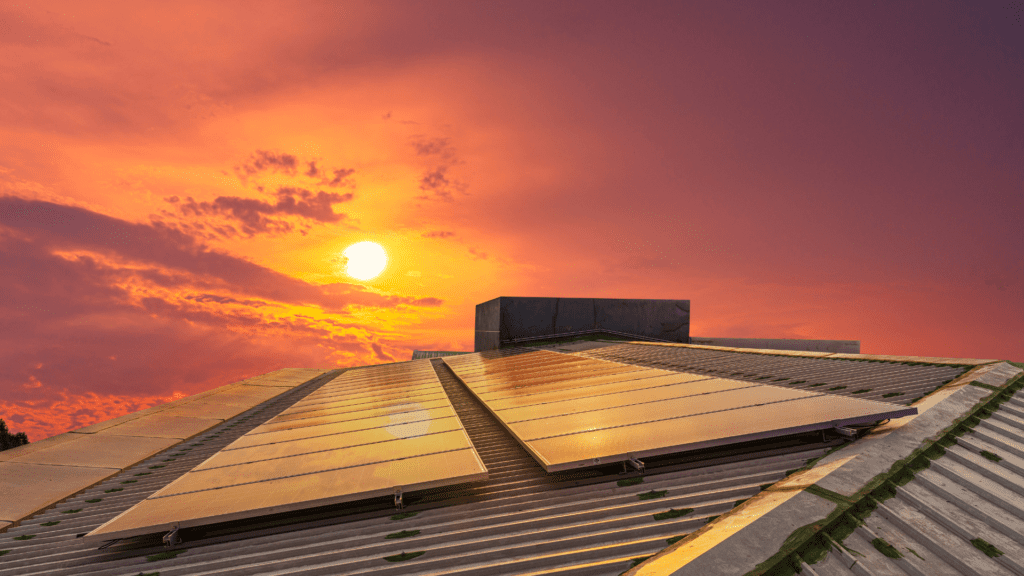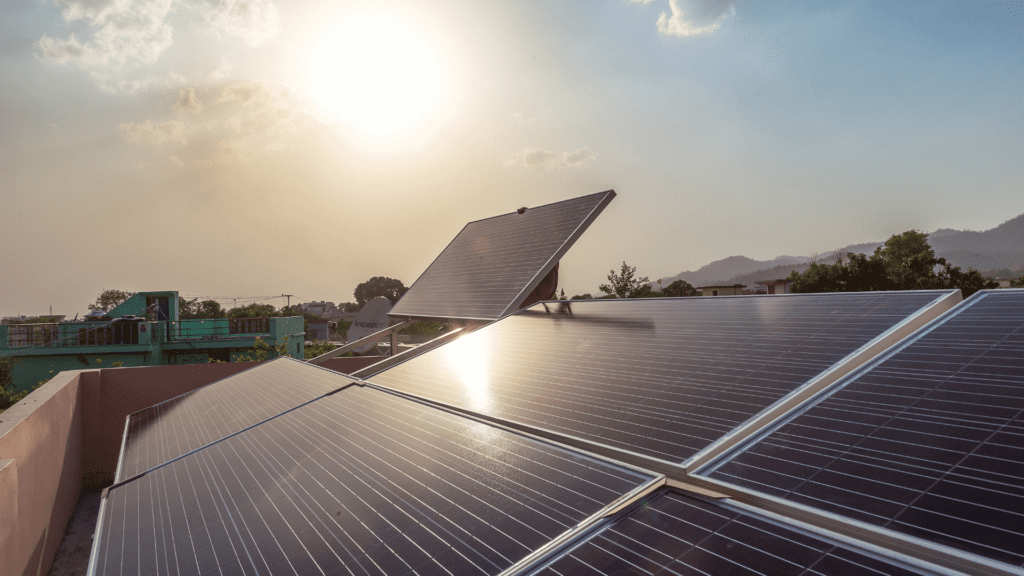The Process of Installing Solar Panels on a Flat Roof
Utilizing solar power on a flat roof presents a remarkable opportunity often overlooked. As pioneers in sustainable energy solutions, Ethical Energy Solar brings a wealth of expertise to the table. Installing solar panels on a flat roof isn’t just feasible; it’s advantageous. Concerned about the process or potential hurdles? Relax.
This guide explores flat roof installations in case you plan to go solar. We will provide insights and solutions to maximize your rooftop’s solar potential.
Let’s explore the seamless integration of solar energy into your flat roof space.
Can You Install Solar Panels on a Flat Roof?

Installing solar panels on a flat roof is possible and practical. Contrary to common belief, flat roofs offer an excellent platform for solar installations. The process involves mounting the panels at an angle to optimize sun exposure.
However, it requires precise positioning and adequate support to ensure efficiency and durability. With proper planning and flat roof installation techniques, harnessing solar energy on a flat roof is a viable and effective option for sustainable power generation.
The table below demonstrates the potential variation in solar production based on the installation angle of your panels.
| Panel Angle | Expected Power Loss |
|---|---|
| 45 degrees | 26.25% |
| 40 degrees | 0% (optimal) |
| 35 degrees | 26.25% |
| 20 degrees | 15% |
| 0 degrees | 30% |
| -40 degrees | ~50-80% |
Why Flat Roof Solar Installations are the Best

Easy to install
Installing a solar panel system on a flat roof is smooth sailing and straightforward. With no angled surfaces to worry about, placing panels becomes a breeze. When installing a solar system on flat roofs you don’t have to worry about roof penetrations. Fewer adjustments mean you’ll have a quicker installation, saving time and effort.
The solar panels are kept safe
Flat roofs provide a secure space for solar panels. Panels stay put since they’re not exposed to strong winds from different angles.
Plus, the absence of steep slopes reduces the risk of damage from high winds or heavy snow loads, keeping your investment safe and sound.
Flat panels receive less direct sunlight and experience fewer extreme temperature shifts, which could potentially extend their lifespan compared to those installed at optimal angles for maximized production. This reduced exposure helps prevent overheating, thus enhancing the overall longevity of your panels.
Space efficiency
One big perk of flat roof solar systems? They offer ample space for solar panels. You can fit more panels on flat roofs than a sloped roof. Rest assured, you’ll maximize your energy production potential.
Versatility in design
Flat roofs offer a versatile canvas for solar design. They grant flexibility in placing and arranging panels, allowing for creative layouts that optimize sunlight exposure all day long. Their adaptability means you can strategically position panels to catch maximum sunlight and enhance efficiency.
Accessibility for maintenance
Maintenance on flat roof solar panels is a breeze. Unlike sloped roofs that may require precarious climbs, flat roofs offer a hassle-free path to your panels. With no steep angles to navigate, you can access and maintain your panels without a husstle. This convenience makes routine checks or any necessary upkeep a stress-free experience.
Potential for additional rooftop use
Flat roofs aren’t just for solar panels – they can double up as functional spaces. You can use the roof for other purposes, like creating a rooftop garden, installing HVAC systems, or setting up a cozy hangout spot.
Provide enhanced energy efficiency
With flat roof systems, solar panels can be positioned optimally to capture sunlight throughout the day. This setup maximizes energy production and system efficiency. Your panels are perfectly angled to soak in the most sunshine so your home is under a continuous power supply.
Challenges of Installing Solar Panels on a Flat Roof
One common challenge with flat roof installations is waterproofing. Because, well, flat roofs don’t have the luxury of a slope to help rainwater slide off. When installing panels, you’re poking some holes in the roof, which could pose a risk of leaks if not done properly.
To avoid this, waterproof the roof before installing solar panel systems to prevent unwanted drips. By addressing this challenge effectively, you’ll keep your roof dry and your home protected.
Factors to Consider When Installing Solar Panels on a Flat Roof
Cost
Assess the initial investment versus long-term electric bill savings. While the upfront installation cost might seem high, weigh it against the significant savings on energy bills and the environmental advantages over time.
Leakage risks associated
Installing panels involves penetrating the roof, potentially causing leaks if not sealed properly. Prioritize professional installation with meticulous waterproofing to prevent any water infiltration.
Cleaning and Maintenance
Factor in ongoing maintenance costs. Regular cleaning of panels is essential for optimal efficiency. Decide whether you’ll manage maintenance yourself or opt for a professional service.
Angle and orientation of the panels
The angle of the panels significantly impacts energy production. Ensure panels are angled optimally to capture maximum sunlight throughout the day, enhancing overall efficiency
Structural Integrity
When planning to install solar panels, it’s important to evaluate the roof structure’s load-bearing capacity. A structural assessment is necessary to confirm if it can support the weight of the panels without compromising the roof’s integrity. In some cases, strengthening may be required. This can also help to estimate solar system size.
Maximizing Solar Power and Money Out of a Flat Roof

Choose an angled mounting system
Opt for an angled mounting system on your flat roof to optimize sunlight exposure. This system positions panels at an angle, similar to tilted roofs, to capture more sunlight throughout the day. You’ll give your panels a sunbathing spot, ensuring they soak up as much energy as possible.
Choose a high-efficiency panel brand
Opt for high-efficiency panel brands to optimize your investment. These panels efficiently convert sunlight into electricity, amplifying power production. With these panels, you’re getting the most out of each ray of sunlight, ensuring a solid return on your solar investment.
Look for performance warranty
Go for panels with strong performance warranties for assurance. This warranty guarantees long-term efficiency, acting as an insurance policy for your energy investment. With this warranty, you can trust your panels to deliver consistent performance and reliability throughout their lifespan, offering peace of mind for years ahead.
Optimal Panel Placement
Strategically position panels to evade shading and maximize sunlight exposure. Identifying and addressing potential shade sources ensures optimal placement. Ensuring each panel gets ample sunlight boosts overall efficiency and energy production.
Regular Maintenance
Regularly clear away debris, dirt, or snow that might hinder sunlight absorption. This routine upkeep guarantees optimal panel efficiency by allowing them to harness sunlight without any obstructions continuously.
Monitoring and Upgrading
Monitor your system’s performance and consider upgrades as technology advances. Newer, more efficient panels or technologies might become available, improving your system’s output and saving you more money in the long run.
Energy Storage Solutions
Consider investing in storage solutions like solar batteries. These store excess energy generated during peak sunlight hours for use during evenings or cloudy days.
Although Flat Roof Systems May Be Pricier, They Offer Greater Savings Potential
Although flat roof systems may come with a higher initial cost, they offer greater savings potential in the long run, particularly when integrated with solar systems. The flat nature of these roofs makes them an ideal platform for solar panel installation, transforming your home or business into a hub of renewable energy.
Solar systems have become increasingly popular due to their environmental and economic benefits. By harnessing the power of the sun, they help reduce reliance on non-renewable energy sources, thereby contributing to a greener planet. Simultaneously, they can significantly reduce your energy bills and even provide a source of income if you generate more electricity than you use.
Flat roof systems take these advantages a step further. Flat roofs tend to offer a larger surface area for solar panel installation compared to traditional pitched roofs, allowing for more panels to be installed. More panels mean more solar energy, translating to higher savings and a shorter payback period for your investment.
Solar Installation Cost Factors: Flat Roofs vs Sloped Roofs
There are distinct differences between installing a solar panel system on a flat roof versus a sloped roof. These disparities impact the complexity of the installation, the type of mounting system needed, labor costs, and even the maintenance requirements post-installation.
Flat Roof Solar Installation
Flat roof systems require a specialized approach when it comes to solar installations. The solar panels need to be correctly angled to maximize sun exposure, which may necessitate the use of tilt legs, triangle mounts, or a ballasted racking system. These additional components can increase the cost of a flat roof solar installation. It can also increase the process of how long solar take to install.
Moreover, mounting solar panels on flat roofs often requires non-penetrating racking systems to prevent potential leaks, which are generally more expensive than standard penetrating mounts. Flat roof installations also demand more time and expertise due to their complexity, inflating labor costs. Maintenance can also be more frequent with flat roofs as they tend to accumulate debris easily, affecting the performance of solar panels.
Sloped Roof Solar Installation
On the other hand, sloped roofs offer a roof slope and a natural angle for solar panels, eliminating the need for additional equipment to position the panels for optimal sun exposure. This reduction in material needs can lower the overall cost of the solar panel system.
Mounting solar panels on sloped roofs typically involves standard penetrating mounts, which are less expensive than the non-penetrating racking systems used for flat roofs. The installation process is less complex, leading to lower labor and installation costs. In addition, sloped roofs allow for natural runoff, reducing debris accumulation and therefore, maintenance needs.
However, it’s important to note that each roof type has its own set of challenges. For instance, sloped roofs might require more structural reinforcement to support the weight of the solar panels, which could add to the overall cost.
Why You Should Not Install Solar Panels Horizontally on Flat Roof
Dirt Build-Up: Horizontal placement invites dirt accumulation. With no natural angle for runoff, dust, leaves, and debris settle on panels, reducing the efficiency of the solar system.
Low Energy Production: Horizontal panels receive sunlight at a less-than-optimal angle, reducing energy production. Their flat orientation limits sunlight absorption, minimizing their ability to generate electricity efficiently.
Drainage Issues: Flat panels hinder proper drainage, leading to water pooling. This stagnant water might cause leaks or structural damage, posing risks to your roof’s integrity.
What Type Of Roof Is Not Good For Solar Panels?
Materials like wood and slate aren’t ideal for solar panels due to their brittleness, which complicates the installation process. Solar installers can’t move around on these roofs easily, making installations more challenging and costly.
Flat Roof Solar Installations Cost More but Also Save More

Installing panels on a flat roof demands attention to detail, but the payoff is immense. While the initial cost might be higher, the long-term savings and environmental benefits make it a worthy investment. Remember, maximizing efficiency through proper panel placement and maintenance is key to reaping the full benefits.
At Ethical Energy Solar company, we’re here to guide you toward smarter energy solutions. Flat roofs offer a promising canvas for sustainable energy, and with our expertise, your journey toward an eco-friendly, cost-saving future begins.

